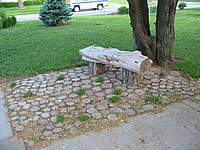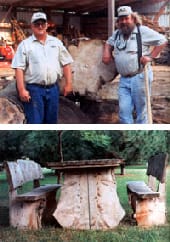|
 The Neighbor's Bench
The Neighbor's Bench
In 2006 we
placed a rustic, custom made
log bench
to compliment the area and serve as a focal point. It provides a shady place for garden breaks or a rest
stop for our neighbors.
After the
stump patio was installed
the fall of 2005, we were looking for a rustic bench that
could compliment the area and serve as a focal point.
While looking through a catalog of Nebraska products, we saw
a listing for a place that builds garden tables and
benches from "rescued" trees.
We setup a time to meet Mark Udey at the mill for us to
select a log and watch them cut the bench. The bench was
installed in 2006.
|
|
Treeincarnaters
960
129th Rd
Stromsburg, NE 68666
(402) 764-4912
mudey@hotmail.com
Mark Udey
|
Sunday, Nov. 13, 2005 |
|

Found a Cedar
Log in the
pile of "rescued" wood.
|
|

Mark Udey
hauling the
log to the mill.
|
|

Setting up
the mill
to cut the log.
|
|

Mark & Ray
making the
first cut- the top.
|
|

The finished
bench. |
|
Even on the Midwestern plains,
there's plenty of wood to be sawn
By Kelly Helm Smith
 |
|
Top: Ray Lindgren (left) and Mark Udey (right), the
Treeincarnaters. Bottom: This picnic table was made from
untreated cedar. |
Being "Treeincarnaters" has become a profitable part-time
business for woodworkers Mark Udey and Ray Lindgren. Their
full-time jobs maintaining roads and mowing give them plenty
of opportunity to observe the changing landscape around
Swede Home, Nebraska. Thrifty by nature, they noticed how
many storm-damaged and bulldozed logs were ending up in
brush piles or landfills—potentially good lumber that only
needed transportation and sawing. After Ray, who makes rolltop desks, watched a custom sawyer turn a log into
lumber, he and Mark decided they wanted to make their own
lumber.
About five years
ago, Mark and Ray became the owners of a small sawmill, for
the price of a new pickup, and built a shed and a solar kiln
for curing lumber.
They had two goals: One was to have fun, now and in the
future: "We want a big pile of free lumber so we can putter
at woodworking when we retire," Mark says. Secondly, they
hoped to make some money, to pay for the sawmill and to
supplement their retirement. They began with one simple
rule: They resolved not to harvest any trees just for
lumber. They would only cut wood that would otherwise go to
waste.
Mark and Ray salvage logs from storm damaged trees in nearby
cities; once they
even followed a tornado to see if it would uproot any
interesting trees. It didn't, but on the way back they
spotted a farmer bulldozing walnut logs to clear more
farmland. They got the owner's permission and salvaged some
of the wood.
Even on the relatively treeless Nebraska prairie, there's
more wood to be salvaged than the Treeincarnaters can
handle. Mark estimates that any city of 50,000 or more
easily generates enough "waste" wood to keep a custom sawyer
busy. "There's no doubt about it," says Dennis Adams,
Nebraska Forest Service program leader for rural forestry,
"a lot of logs go into landfills and burn piles."
In just three
years, the mill has paid for itself. The Treeincarnaters
earn money from custom sawing—customers either pay by the
hour or in shared lumber. Mark and Ray also sell boards and
their own finished products. They build flower boxes, make
picture frames from knotholes, and create rustic benches and
tables. And nothing goes to waste: They fashion lower-grade
lumber into cattle feed bunks.
A favorite part of the process for Mark and Ray is the first
few cuts into each log, which give them a glimpse of the
wood's pattern. "Each tree has its own personality," Ray
says. "We're getting to where we can see what's in each
tree."
|